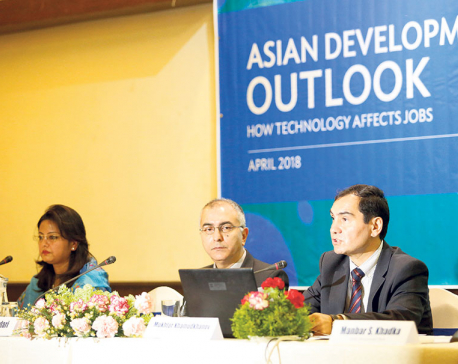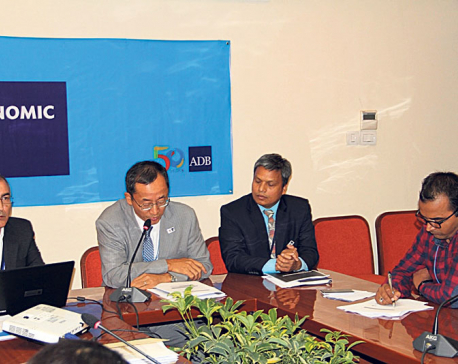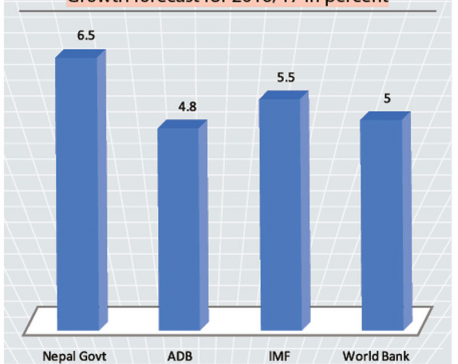
OR
ADB forecasts 4.7 percent economic growth for Nepal
Published On: September 27, 2017 03:30 AM NPT By: Republica | @RepublicaNepal

KATHMANDU, Sept 27: Asian Development Bank (ADB) has forecast the Nepali economy to grow only by 4.7 percent in Fiscal Year 2017/18.
Releasing the 'Macroeconomic Update: Nepal (September 2017)' on Tuesday, the Manila-based development partner said that the economy will likely grow at a slower rate of 4.7 percent in the current fiscal year largely due to heavy rainfall during this monsoon that affected paddy and other major crops in the Tarai belt which is considered to be the breadbasket of the country.
The World Bank last week said that Nepal's economic growth rate is likely to moderate to 4.6 percent in the current fiscal year.
Both multilateral development partners have attributed the recent floods in Tarai as a major reason to the possible slowdown in economic growth.
“Heavy rainfall since mid-August led to landslides and floods, resulting in the loss of human lives and livelihoods. Floods inundated paddy fields and destroyed crops in most of the Tarai districts,” read the ADB report. “This will depress farm output, hampering growth prospect.”
The ADB has also said that the transition to federal system will weigh on the economic growth of the country. The World Bank has also pointed out the lack of clarity regarding fiscal architecture as a dampener for the economic growth.
“Though dates for provincial and federal level elections have been announced, several bills, namely, Natural Resources and Fiscal Commission including Inter-governmental Fiscal Transfer imperative for effective implementation of fiscal federalism have yet to be enacted,” read the periodic report released by the ADB. “In the absence of these bills, distribution of natural resources and revenue among all three tiers of the government will be affected, hampering growth prospect in FY 2018.”
Like in the previous fiscal years, delay in the implementation of development projects is going to be another obstacle for economic growth in the current fiscal year. “Implementation delays of national pride projects have continued in FY 2018. This will likely lead to a substantial shortfall in capital expenditure and depress economic growth,” the ADB stated in its report.
Toward the monetary sector, the ADB said that inflation is likely to rise in the current fiscal year but remain below the average 8.9 percent of price rise in the past last decade. According to the ADB, the inflation is expected to pick up to 6.5 percent in the current fiscal year, up from 4.5 percent in the last fiscal year. The proposed expansionary budget for the current fiscal year, including the fiscal transfer and election expenditures as well as the depressed farm output and infrastructure damage from the recent floods, could raise the inflationary pressure, according to the ADB report.
The two multilateral institutions' forecast in the current fiscal year is far lower than the government's target of achieving 7.2 percent economic growth in the current fiscal year.
Nepal achieved economic growth of 7.5 percent in the last fiscal year -- the highest since FY 1993/94, on the account of low base of the previous fiscal year, rise in agricultural output on the back of one the best monsoons in recent years, improvement in industrial growth amid end of power cut, and strong revival of growth in tourist arrivals.
You May Like This

ADB anticipates 4.9 percent growth for Nepal
KATHMANDU, April 12: Asian Development Bank (ADB) has said that Nepal's economy is anticipated to grow by 4.9 percent in the... Read More...

ADB projects 4.8 percent economic growth for 2016/17
KATHMANDU, Sept 17: Asian Development Bank (ADB) has projected the economy to grow by 4.8 percent -- due to continued normalization... Read More...

Why do the economic growth forecasts differ?
KATHMANDU, Jan 24: The International Monetary Fund (IMF) has said that the Nepali economy will grow by 5.5 percent in Fiscal... Read More...









Just In
- Heavy rainfall likely in Bagmati and Sudurpaschim provinces
- Bangladesh protest leaders taken from hospital by police
- Challenges Confronting the New Coalition
- NRB introduces cautiously flexible measures to address ongoing slowdown in various economic sectors
- Forced Covid-19 cremations: is it too late for redemption?
- NRB to provide collateral-free loans to foreign employment seekers
- NEB to publish Grade 12 results next week
- Body handover begins; Relatives remain dissatisfied with insurance, compensation amount








Leave A Comment